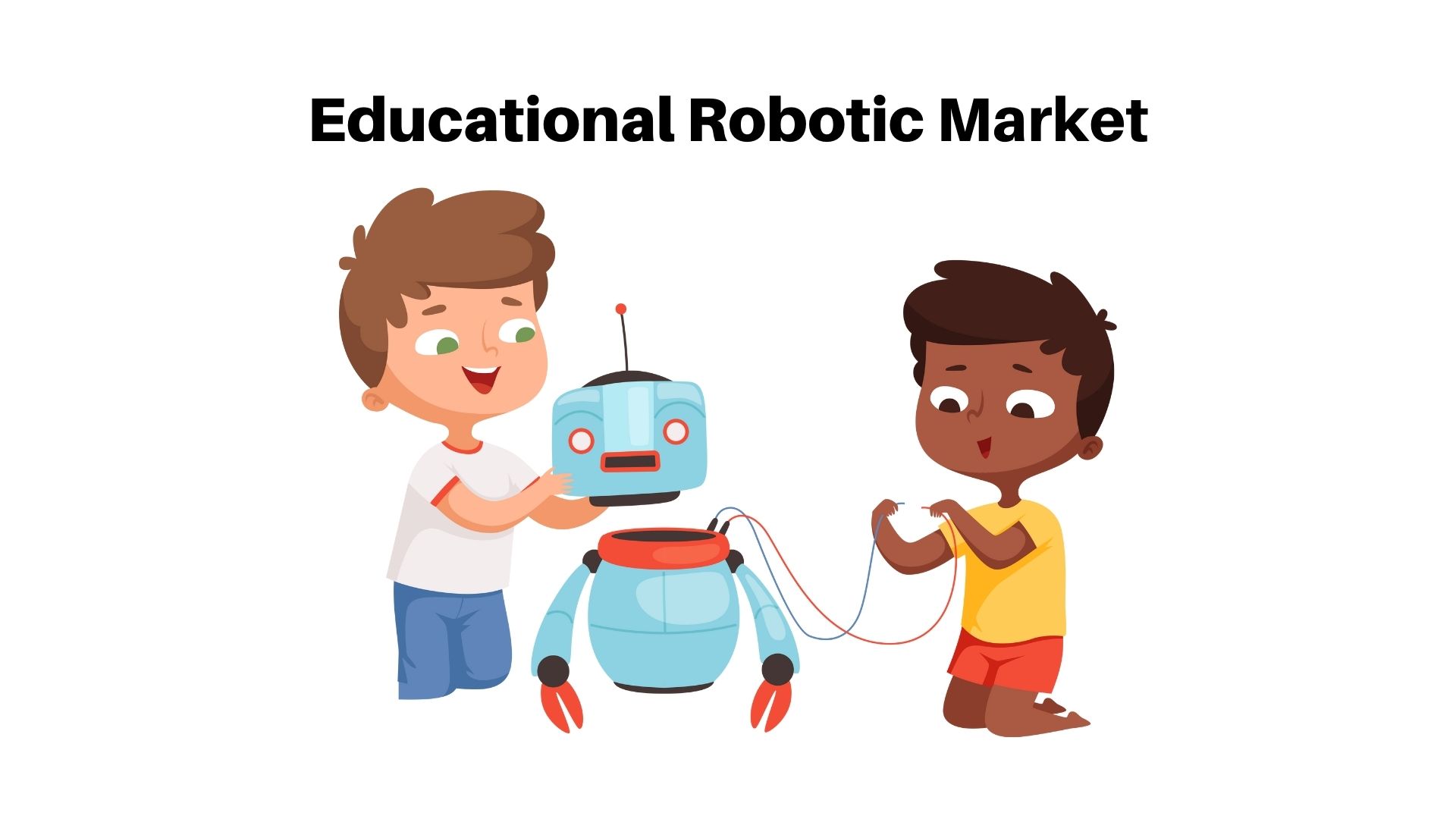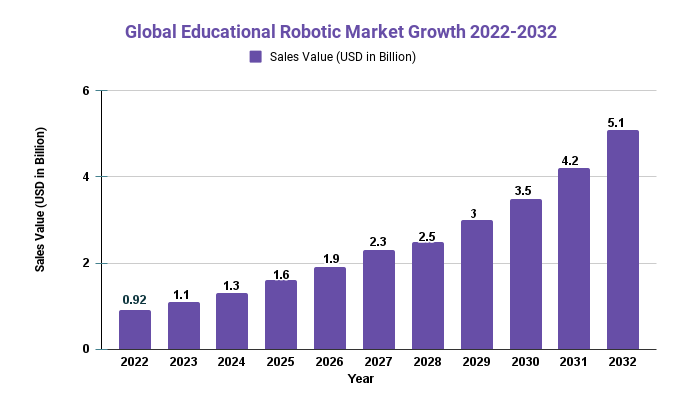Educational Robotic Market to Garner Bursting Revenues with CAGR rate of 19.3%, 2022-2032

Page Contents
Market Overview
Published Via 11Press: The Educational Robotic Market size is expected to be worth around USD 5.1 Bn by 2032 from USD 0.92 Bn in 2022, growing at a CAGR of 19.3% during the forecast period from 2022 to 2032.
The educational robots market is rapidly growing, with more and more schools and educational institutions adopting this innovative technology to enhance student learning. Educational robots are designed to help students learn different subjects such as math, science, and coding in a fun and interactive way. These robots come equipped with sensors, cameras, microphones, speakers, and other advanced features that enable them to interact with students in a personalized way.
The demand for educational robots is increasing due to the benefits they offer. For instance, they help teachers deliver engaging lessons while also providing students with opportunities to practice problem-solving skills. Additionally, these robots can be used by teachers from different disciplines ranging from STEM subjects like physics or biology to the arts like music or painting. They provide an excellent platform for students with different abilities including those who may have learning difficulties or disabilities.
Request For Sample Report Here: https://market.us/report/educational-robots-market/request-sample/

Key Takeaways
- Growing Demand: The demand for educational robots is on the rise due to an increasing focus on STEM (Science, Technology, Engineering, and Mathematics) education and the need for engaging teaching methods.
- Adoption Trend: Educational institutions and schools are increasingly implementing educational robots to enhance students' learning experience and give them a practical grasp of STEM concepts.
- Diverse Applications: Educational robots have numerous uses across fields like programming, robotics, engineering, and science making them suitable for a range of educational activities.
- Advanced Technology: Educational robots are now adopting cutting-edge technologies like Artificial Intelligence, machine learning, and computer vision to expand their capabilities and deliver more sophisticated educational experiences.
- Competent Market Environment: The educational robot market is becoming increasingly competitive, with an influx of players entering the space, stimulating innovation and product diversification.
- Regional Growth: The educational robot market is experiencing strong growth in Asia Pacific, particularly China, due to an increasing emphasis on STEM education and the adoption of cutting-edge educational technologies.
Regional Analysis
- The North American educational robot market is mature and highly competitive, with a high adoption rate for technology in education. The United States leads this region with several major players present.
- Europe has become a highly developed market for educational robots, with an aim to offer innovative teaching methods and improve students' learning experiences. Top markets in this region include the United Kingdom, Germany, and France.
- The Asia Pacific region is experiencing significant growth in the educational robots market, driven by an emphasis on STEM education and innovative educational technologies. China leads this region with a high demand for these robots among schools and educational institutions.
- The Middle East and Africa market for educational robots is experiencing strong growth, driven by a focus on improving educational quality as well as preparing students for future employment opportunities. Major markets in this region include UAE, Saudi Arabia, and South Africa.
- The Latin American market for educational robots is currently small but expected to expand significantly over the coming years, driven by a desire to improve educational quality and enhance students' experiences. Brazil, Mexico, and Argentina are some of the major players in this region.
Drivers
- Increased Focus on STEM Education: With the growing importance of STEM education in prepping students for the future job market, educational robots are seen as a useful tool for imparting STEM concepts in an engaging and practical manner.
- Technological Advancements: Educational robots are adopting cutting-edge technologies like Artificial Intelligence, machine learning, and computer vision to expand their capabilities and offer more sophisticated educational experiences.
- Interactive and Engaging Learning Environment: Educational robots offer an interactive, engaging way of teaching which can boost student motivation, boost retention rates, and enhance the overall learning experience.
- Rising Demand for Personalized Learning: Educational robots can be programmed to adapt their pace and style of teaching according to each student, creating tailored learning experiences tailored to diverse student requirements.
- Accumulating Awareness and Adoption: With increasing public awareness about educational robots, there has been an uptick in their adoption by educational institutions and schools, fuelling the growth of this market.
- Government Initiatives: Governments around the world are investing in STEM education and cutting-edge educational technologies, creating a favorable climate for the growth of the educational robots market.
Restraints
- High-Cost: Educational robots can be expensive, which can limit their adoption in some educational institutions and schools, particularly in developing countries.
- Limited Functionality: Some educational robots may have limited functionality, which may not provide a comprehensive educational experience for students.
- Technological Complexity: The advanced technologies incorporated in educational robots may require specialized knowledge and skills to operate and maintain, which can be a challenge for some educators and students.
- Lack of Standardization: There is a lack of standardization in the design and development of educational robots, which can make it difficult for educators and students to compare and evaluate different products.
- Cybersecurity Concerns: Educational robots may collect and store sensitive information about students, such as their personal information, learning progress, and performance. This can raise concerns about data privacy and cybersecurity.
- Competition from Alternative Technologies: Educational robots faces competition from alternative technologies such as virtual and augmented reality, which may provide similar or better educational experiences at a lower cost.
Opportunities
- Rising Demand in Emerging Markets: The educational robots market has an immense potential to expand in emerging regions such as Asia-Pacific, the Middle East and Africa, and Latin America due to rising demand for innovative educational technologies and an emphasis on improving educational quality.
- Adoption in Higher Education: Educational robots are seeing an increasing adoption within higher education institutions, particularly in fields such as engineering, computer science, and robotics creating a significant opportunity for market growth.
- Customized Solutions for Special Needs: Educational robots can be tailored to meet the individual needs of students with special needs, creating a more inclusive learning atmosphere and opening up an entirely new market segment in this sector of the industry.
- Integration with Learning Management Systems: Combining educational robots with learning management systems and other educational technologies can offer students a more comprehensive and unified educational experience, creating new opportunities for partnerships and collaborations.
- Collaborations with Educational Institutions: Collaborations between educational robot manufacturers and educational institutions can offer unique opportunities for product testing, research, and development that lead to more efficient and advanced educational robots.
- Rising Investment in Educational Technologies: There has been an impressive investment in educational technologies by governments, private organizations, and investors, creating an ideal environment for the growth of the educational robots market.
Challenges
- Integration with Traditional Curriculum: Integrating educational robots into the traditional curriculum can be a challenge, particularly in schools and institutions that may not have the necessary resources or infrastructure to support these technologies.
- Lack of Qualified Educators: Educational robots require skilled and qualified educators who can effectively integrate them into the curriculum and facilitate a positive learning experience for students.
- Resistance to Change: Resistance to change and reluctance to adopt new educational technologies can be significant challenges to the growth of the educational robots market, particularly in traditional educational settings.
- Short Product Lifecycle: The educational robots market is characterized by a short product lifecycle, with rapid technological advancements and changing market trends, which can create challenges for manufacturers in terms of product development and innovation.
- Intellectual Property Protection: Intellectual property protection can be a challenge in the educational robots market, particularly with the potential for imitation and infringement of patented technologies.
- Ethical Considerations: The use of educational robots raises ethical considerations such as data privacy, cybersecurity, and the impact of technology on student learning and well-being, which need to be addressed by manufacturers, educators, and policymakers.
Browse the summary of the report and Complete Table of Contents (TOC): https://market.us/report/educational-robots-market/table-of-content/
Recent Development
- August 2022: Google will be focusing its efforts on the market for humanoid robots. Researchers at google's lab developed AI software that integrates large language models and helps humans accomplish everyday tasks. This research will also drive homeschooling reforms in the near future.
- March 2022: ElliQ was officially launched by Intuition Robotics and is currently available for purchase at elliq.com.
Report Scope
| Report Attribute | Details |
| The market size value in 2022 | USD 5.1 Bn |
| Revenue forecast by 2032 | USD 0.92 Bn |
| Growth Rate | CAGR Of 19.3% |
| Regions Covered | North America, Europe, Asia Pacific, Latin America, and Middle East & Africa, and the Rest of the World |
| Historical Years | 2017-2022 |
| Base Year | 2022 |
| Estimated Year | 2023 |
| Short-Term Projection Year | 2028 |
| Long-Term Projected Year | 2032 |
Key Market Segments:
By Product Type
- Humanoid
- Non-Humanoid
By Application
- Primary
- Secondary
- Higher
- Others
Market Key Players:
- Aisoy Robotics
- Blue Frog Robotics & Buddy
- Innovation First International Inc.
- LEGO System A/S
- Makeblock
- Modular Robotics
- Pal Robotics
- Pitsco Inc.
- Robotis
- Other Key Players
Frequently Asked Questions
What is the market study period?
The Educational Robotic Market is studied from 2017 – 2032.
What is the growth rate for the Educational Robotic Market?
The Educational Robotic Market is growing at a CAGR of 19.3%Which region experiences the highest rate of growth in the Educational Robotic Market?
Asia Pacific is growing at the highest CAGR over 2022- 2032.
Which region is the largest in the Educational Robotic Market?
North America holds the highest share in 2022.
Who are the major players in the Educational Robotic Market?
Aisoy Robotics, Blue Frog Robotics & Buddy, Innovation First International Inc., LEGO System A/S, Makeblock, Modular Robotics, Pal Robotics, Pitsco Inc., Robotis, Other Key Players
The team behind market.us, marketresearch.biz, market.biz and more. Our purpose is to keep our customers ahead of the game with regard to the markets. They may fluctuate up or down, but we will help you to stay ahead of the curve in these market fluctuations. Our consistent growth and ability to deliver in-depth analyses and market insight has engaged genuine market players. They have faith in us to offer the data and information they require to make balanced and decisive marketing decisions.



